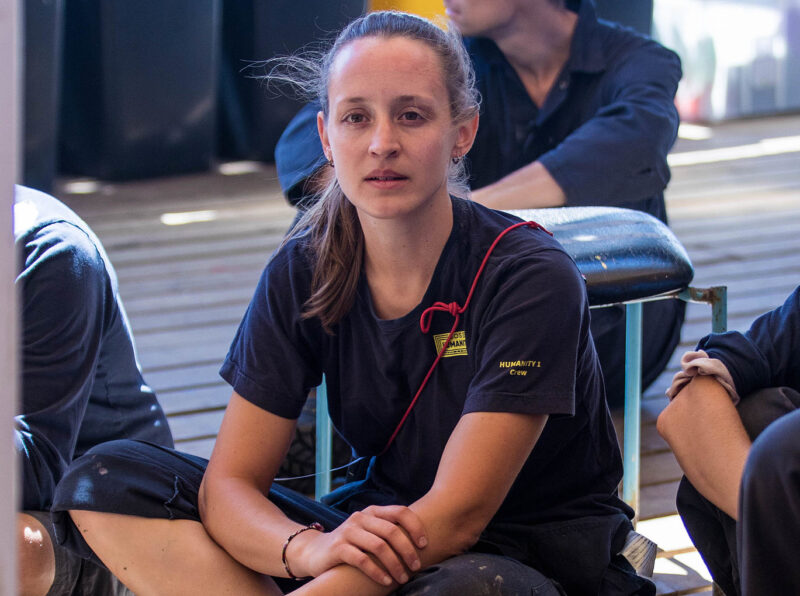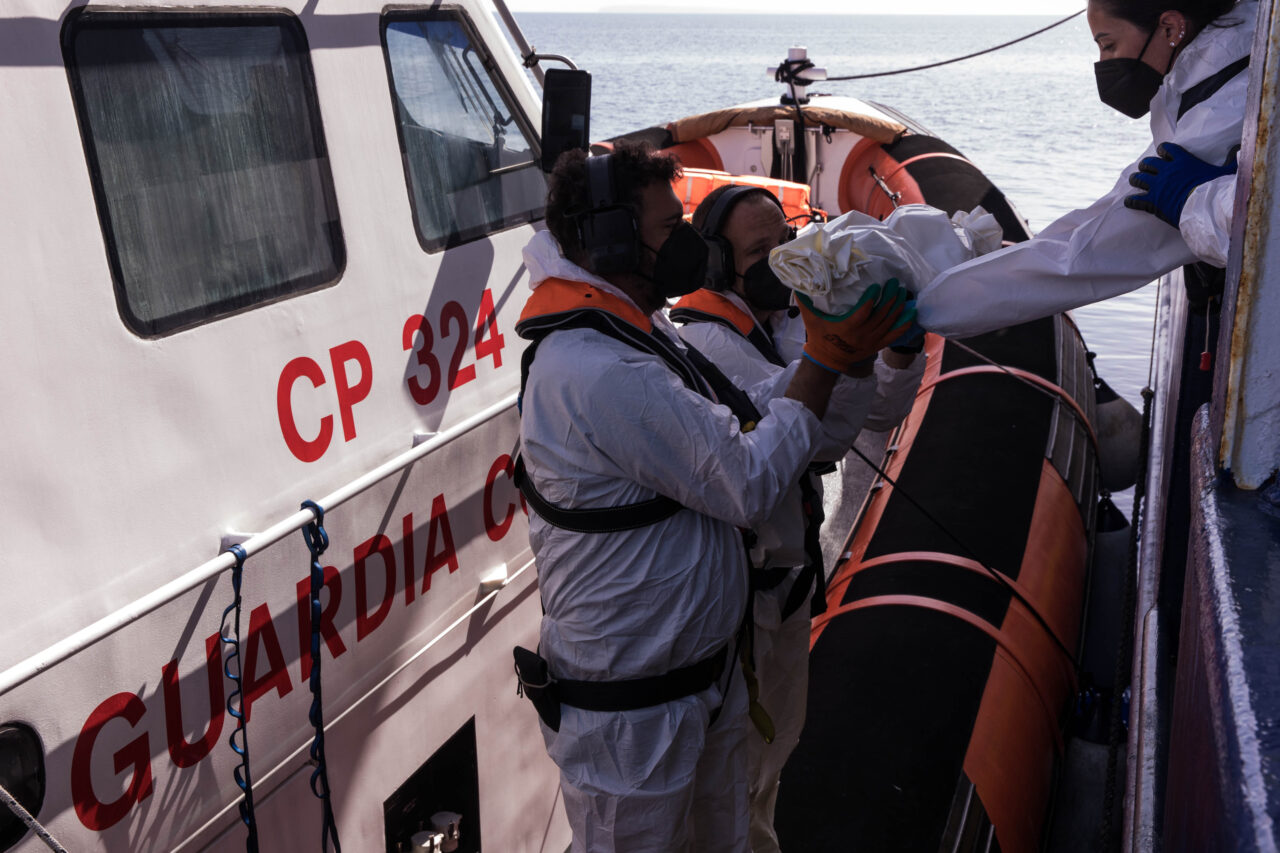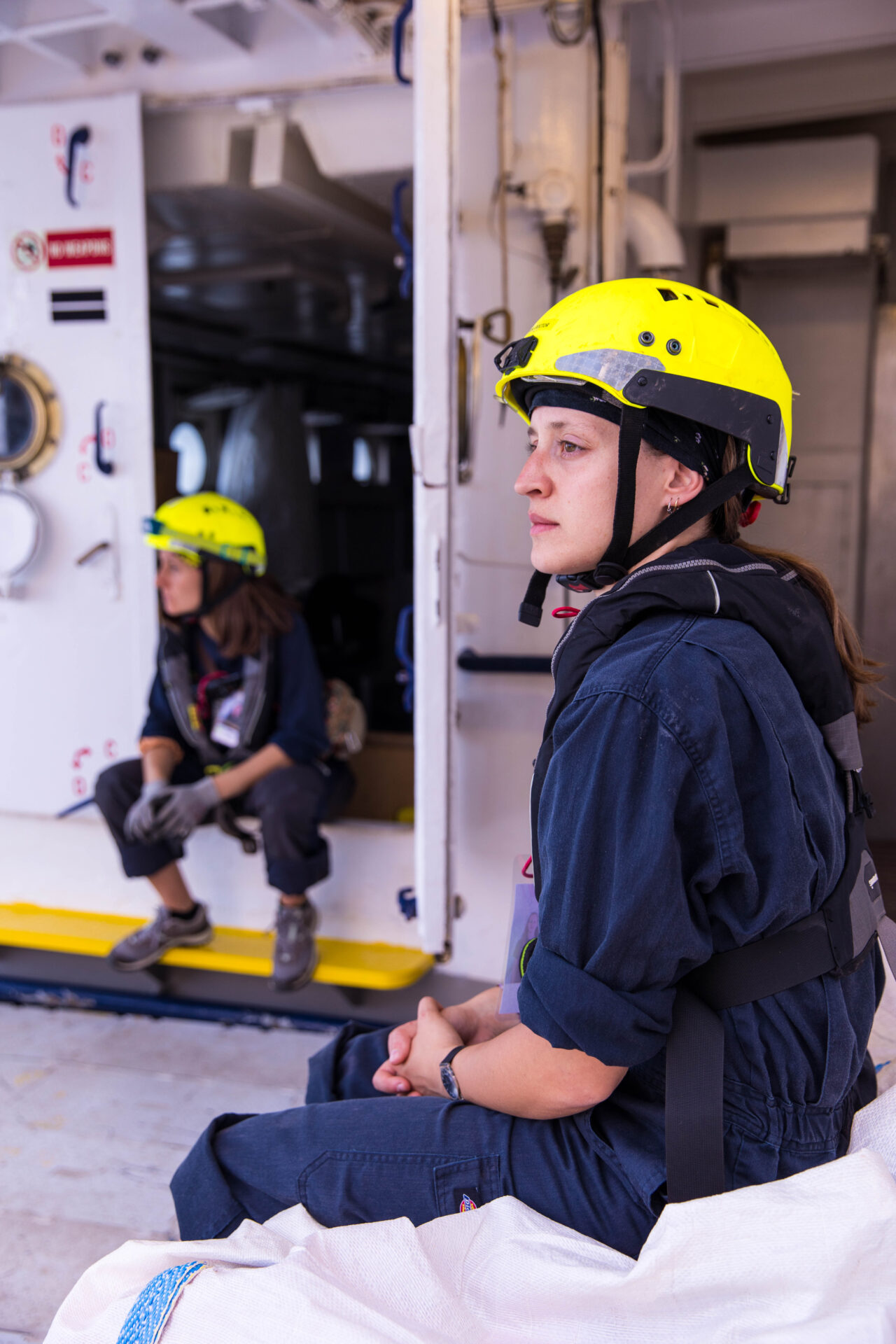“Letting them drown is not an option”

The experiences of Maria, a Swiss doctor involved in refugee and migrant rescue operations in the Mediterranean Sea. A version of this text by Angela Nocioni, external journalist for Humanity 1’s 12th rescue mission, was originally published in Italian in the magazine Azione on 08/07/2024.
She is 30 years old, her name is Maria. She is an emergency doctor, she is Swiss. She lives between Bern and Basel. She is in charge of the medical team on board the ship Humanity 1, of the German NGO SOS Humanity. We accompanied her on operations between May and June 2024. We are patrolling the international waters off the coast of Libya, using binoculars from the bridge to spot refugees and migrants in makeshift boats before they are captured by the Libyan Coast Guard. Armed with patrol boats, the Libyan Coast Guard works to bring them back to collection points where – according to testimonies – it is easy to encounter floggings, rapes and violence of various kinds. Maria works with Letizia, an Italian nurse from Marina di Carrara; Izaro, a Basque midwife; Sabrina, a German psychologist; and another doctor, Nico, also German, who drives one of the fast rescue boats (rigid-hull inflatable boats, or RHIBs). All are very young.

On this voyage, Maria coordinates the medical first aid for a hundred or so people who have rescued, treats the burns from the scalding mixture of fuel and sea water, and is responsible for reviving dehydrated and hypothermic people. And she tries in vain to revive a five-month-old girl from Guinea, already lifeless when hoisted aboard. She remained in a drifting boat for at least three days, without water, without food, without milk, with dozens and dozens of other dehydrated people, intoxicated by petrol fumes.
It will be Maria who will talk to the wide-eyed mother, still in shock. It will be Maria who takes care of both mother and sister with an impressive calm, respect and competence. The deck is now full of survivors, all rescued in the last 48 hours, sleeping wherever there is room to lie down, between the showers and containers. “Why are they on board?” begins Maria. “Because letting them drown is not an option, because the right to live is a basic human right.
Eight years ago I went to the island of Lesvos, to a refugee camp, as a volunteer. I was a student. It was full of refugees and migrants who had survived shipwrecks in the Mediterranean trying to come to Europe. Since then, I have graduated in medicine, I started working in an hospital and in the Mediterranean we still see the same atrocities, every day, and now it is even worse because the daily shipwrecks has disappeared from the news.”
There is a high level of care on Humanity 1, including a small clinic that functions as a field hospital. Maria teaches all the crew how to do CPR, how to use the defibrillator. She recounts: “I hear comments on land like: ‘You even treat them on board? You saved them, you saved them from certain death, is there a need to have a clinic? They should be glad they didn’t die, why have medical care on board?’ Now, this is an absurd argument that I do not understand.”

It is three o’clock in the morning. A beam of white light captures, illuminated in the darkness, an overloaded boat. A large merchant ship has seen it and stopped to wait. Too big to approach without risk, unsuitable for rescue, it has kept an eye on the boat until eight hours later the fast rescue boats with lifejackets are launched from Humanity 1. From the Maritime Rescue Coordination Centre in Rome came the authorisation for the rescue: a ‘transhipment’. There are 42 people, 22 minors, 19 of whom are travelling alone. At sea for three days, this is their second night adrift. The engine has broken down. The waterline at the stern is very low, strong winds are blowing, waves of salt water are coming in. They are intoxicated by fuel fumes. They are all cold, dehydrated, soaked. One by one they are brought aboard.
Under the flickering neon light, a row of young faces in disarray. Tariq is very thin, a child’s face cloaked in fear. He does not speak, will not speak all night, he is shivering. From the line for blankets, a boy staggers out. He is hungry, his hands dry with salt spray are unable to grip the rescue kit. He cannot reach the bathroom by himself. He is afraid to close the door. A 15-year-old boy in the blue jersey of Italy’s national football team comes up. He sits hugging a smaller one in a red AC Milan acetate jacket. A tall skinny boy runs around barefoot looking for a knife to open the tape in which his mobile phone is wrapped. “Maman, maman,” he whispers, wanting to tell his mother that he is alive, that he has made it. He shows the off-white T-shirt under his jacket: ‘Venice’. Another boy, another football jersey: Özil, 8 years old. They sit on the benches in silence, watch the white foam of the waves on the hull of the stern, the oldest one points to two tall orange flames on the horizon, oil platforms.
It is early in the morning. On duty with the bridge binoculars is Izaro, the midwife. She shouts. There is a black dot on the edge of the horizon. We discover later that there are 28 people, two children aged four and six months, a two-year-old, a pregnant woman, stranded in the waves in a five-metre blue wooden boat. They left the night before from the Libyan coast. The base of the engine fell off, they were left without a propeller. Adrift. We launch the RHIBs (fast rescue boats)*. The first one to return is full of very young boys. Two arms push a woman in a long yellow, red and black printed dress up onto the ladder. From the ship two hands reach out, grab her. She has made it. She throws herself to the ground on her knees, crying, a shout of joy. Her daughter, only a few months old, already on board, looks at her in silence, she does not cry. Her gaze moves earnestly from her mother’s wet forehead, on deck, to the sea outside. The girl is still sitting on her heels, face down, sobbing and laughing. Motionless, she seems far away from everything, physically drained. She raises her eyes, repeats in French: “I never imagined, Libya, I never imagined”. Finally she lets herself be pulled up, walks barefoot to the large space reserved aft for women and children. She puts one foot uncertainly over the threshold, looks at the painted walls, the changing table, the nappies. She looks at the door, hesitates. Then she enters and sees: the sink with drinking water, the mirror, the large bunk beds, the blankets, the shampoo. “Pour moi?” “For me?” She sits down, strokes the blue mattress with her hand, gets up, walks around, sits back down, gets undressed, steps into the shower. She opens the stall wide, waves to come closer. Under the falling water, she says ‘Merci’ with a heart-rending smile.
Nico, the doctor on board the first rescue boat, recounts: “When we approached, the smell of fuel was very strong. I saw a forest of hands, someone was praying, someone was laughing, everyone was shouting. Loudest of all were the cries of the children.”
He says: “There were five dolphins under our RHIB, one jumped high towards the bow as we approached. A stout, heavy woman suddenly threw her arms out and grabbed a line of the dinghy to come on board herself, she didn’t want to wait for the transhipment. A wave came up, pushed the dinghy away from the boat, she was left with her body outside the boat, she was about to fall into the water. Fares, the Syrian Cultural Mediator, picked her up and with a tug pulled her back in. “I saw so much vomit inside their boat”, he says, “so much vomit and urine.”
*RHIBs: Rigid-Hull Inflatable Boats


